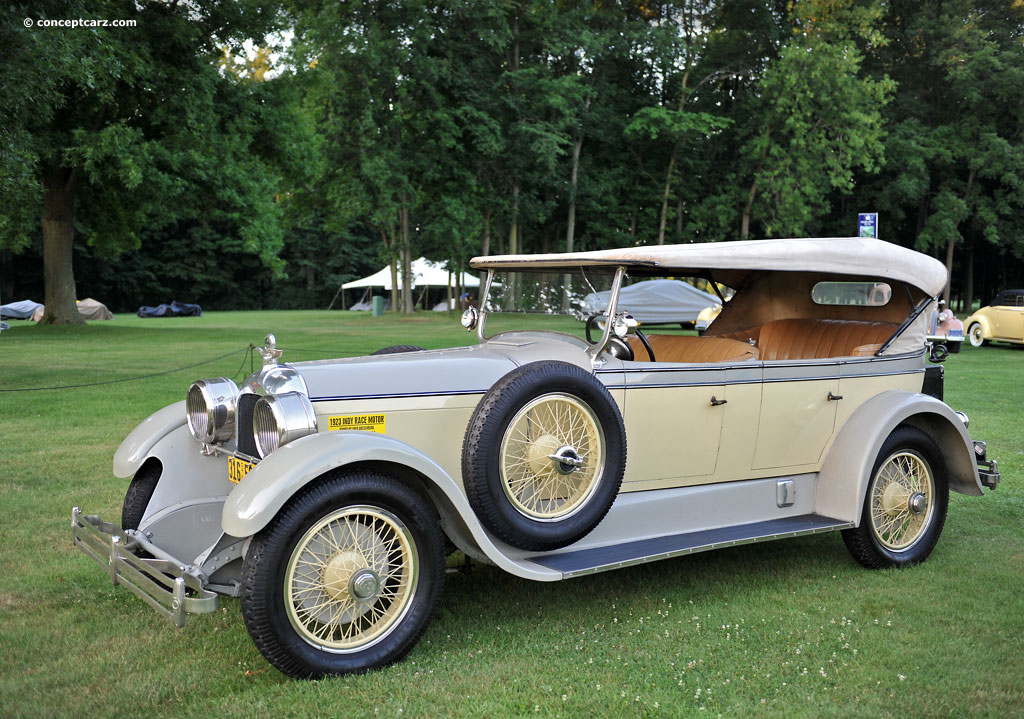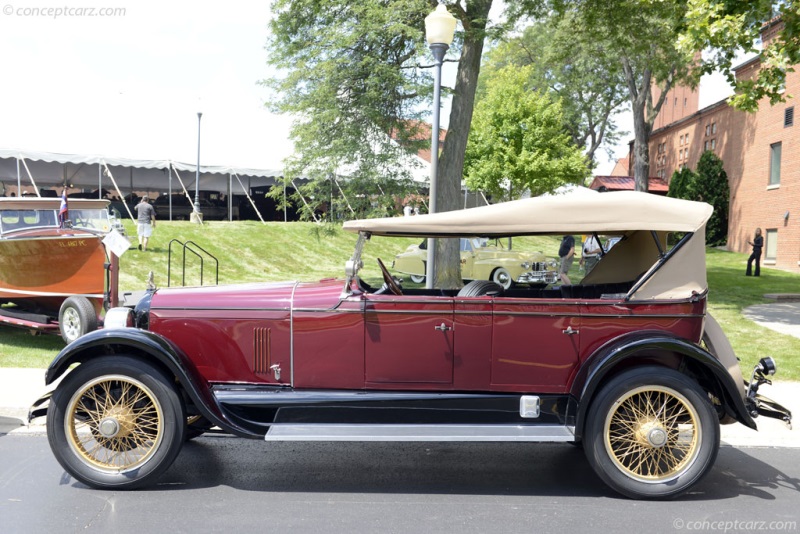1925 Duesenberg Model A Navigation
Brothers August and Frederick Duesenberg founded the Duesenberg Motors Company in 1913 in Saint Paul, Minnesota with the purpose of building engines and race cars. Frederick had been a bicycle racer whose resume included working for Thomas Jeffery, the Wisconsin manufacturer of Rambler bicycles. The brothers opened a garage in Iowa, and around 1905 they began designing and building a two-cylinder automobile which they marketed as the Mason, named for the local attorney who provided the funding for the company. With Fred behind the wheel, the Mason was driven to a number of victories at races and hillclimb events. Following their passion, they sold their interests in the Mason Motor Car Company and moved to Minnesota. The automobile and marine engines that followed were based on the Mason racing engine and used horizontal valve rocker arms. They were called the 'walking beam' engines and would power Duesenberg races cars from 1914 forward. Prior to World War II, drivers such as Eddie Rickenbacker and Ralph Mulford claimed many victories in Duesenbergs prior to World War I. In 1916 they relocated their operation to Elizabeth, New Jersey to build Bugatti-designed aero engines for World War I. Willys would later acquire this factory. After their government contract was canceled in 1919, they moved to Indianapolis, Indiana, and established the Duesenberg Automobile and Motors Company, Inc. Duesenberg had experimented with a prototype straight-eight passenger car and a single overhead cam inline-eight racing engine. Dubbed the Model A, it was introduced in November of 1920 at New York's Hotel Commodore. Power was from a straight-eight engine that used the 'walking beam' configuration rather than an overhead cam. Production followed in 1922 and by this point in history, the cars were powered by the overhead cam eight.
The Duesenberg Model A was given hydraulic brakes in the front and back which was a rather sophisticated feature for the era. Along with Rickenbacker and the one-off Colonial, Duesenberg was one of the first American automobiles to be so-equipped.
Sales were initially slow due to the $6,500 price tag which meant it was $1,250 more than a Pierce-Arrow and $2,650 higher than a Packard. Even with the steep price tag, the cars were never profitable.
Although the Model A was not a sales success, it did find success on the race track. A Duesenberg won the French Grand Prix in 1921 and Indianapolis the following year, where eight of the top ten finishers were powered by Duesenberg engines. The overhead-cam engine initially displaced 183 cubic inches, to fit the Indy formula. It later grew to 260 cubic inches for the production car. The 88-horsepower engine was backed by a three-speed manual transmission. The ladder-style 134-inch wheelbase chassis had a conventional design, with solid front and live rear axles with semi-elliptic leaf springs.
Along with the steep price, the early Model A vehicles had normal start-up problems that eventually got resolved. By this point, however, cash flow had become a problem, for the company was undercapitalized.
Near the close of 1926, the company was saved by E.L Cord's and became part of his Auburn Automobile Company. Mr. Cord instructed Fred Duesenberg to design a grand supercar that would rank among the best in the world. The car that followed was the Duesenberg Model J. Although the Model A had been significantly advanced for its era, it will always be in the shadow of its younger and much larger brother, the legendary Model J. Nevertheless, the Model A outshone other passenger cars it passed along the roadway, with its elegant designs, race-bred overhead-cam eight-cylinder engine, and four-wheel hydraulic brakes.
Over 500 examples of the Model A cars were built, slightly more than the number of Model Js built. Bodies were supplied by many of the traditional coachbuilders, like Brunn and Fleetwood, although a few phaeton and sedan styles were built in quantity by Millspaugh & Irish of Indianapolis. Only about 35 examples of the Model A Duesenberg are known to survive.
by Daniel Vaughan | Jan 2020
The Duesenberg Model A was given hydraulic brakes in the front and back which was a rather sophisticated feature for the era. Along with Rickenbacker and the one-off Colonial, Duesenberg was one of the first American automobiles to be so-equipped.
Sales were initially slow due to the $6,500 price tag which meant it was $1,250 more than a Pierce-Arrow and $2,650 higher than a Packard. Even with the steep price tag, the cars were never profitable.
Although the Model A was not a sales success, it did find success on the race track. A Duesenberg won the French Grand Prix in 1921 and Indianapolis the following year, where eight of the top ten finishers were powered by Duesenberg engines. The overhead-cam engine initially displaced 183 cubic inches, to fit the Indy formula. It later grew to 260 cubic inches for the production car. The 88-horsepower engine was backed by a three-speed manual transmission. The ladder-style 134-inch wheelbase chassis had a conventional design, with solid front and live rear axles with semi-elliptic leaf springs.
Along with the steep price, the early Model A vehicles had normal start-up problems that eventually got resolved. By this point, however, cash flow had become a problem, for the company was undercapitalized.
Near the close of 1926, the company was saved by E.L Cord's and became part of his Auburn Automobile Company. Mr. Cord instructed Fred Duesenberg to design a grand supercar that would rank among the best in the world. The car that followed was the Duesenberg Model J. Although the Model A had been significantly advanced for its era, it will always be in the shadow of its younger and much larger brother, the legendary Model J. Nevertheless, the Model A outshone other passenger cars it passed along the roadway, with its elegant designs, race-bred overhead-cam eight-cylinder engine, and four-wheel hydraulic brakes.
Over 500 examples of the Model A cars were built, slightly more than the number of Model Js built. Bodies were supplied by many of the traditional coachbuilders, like Brunn and Fleetwood, although a few phaeton and sedan styles were built in quantity by Millspaugh & Irish of Indianapolis. Only about 35 examples of the Model A Duesenberg are known to survive.
by Daniel Vaughan | Jan 2020
Related Reading : Duesenberg Model A History
Brothers Fred and August Duesenberg will be remembered always for their outstanding motorcars. True perfectionists and genius engineers, the Duesenbergs were responsible for some of the very best racing and road-going cars in the world from the building of their first cars in 1913 until the last automobiles to bare their name was produced in 1937. But while all Duesenberg cars were outstanding....
Continue Reading >>
Continue Reading >>
- 1925 Duesenberg Model A Menu
- Article
- Image gallery
- Valuation
- Specifications
- Profiles
- Production figures
Duesenberg
Similar Automakers
1925 Duesenberg Model A Vehicle Profiles
Recent Vehicle Additions
Performance and Specification Comparison
Price Comparison
Model A Specification Comparison by Year
Year
Production
Wheelbase
Engine
Prices
Related Automotive News

Historic and Prestigious Classics to Take Center Stage at Gooding & Company's Pebble Beach Auctions; Full Catalogue Launches Online Today
The undisputed star of the show is the 1937 Bugatti Type 57SC Atalante, alongside a 1930 Bentley 4 12 Litre Supercharged Blower Sports Tourer and a 1931 Bentley Eight Litre Sports Tourer.
The official auction house of the Pebble Beach Concours...

Historic Bugatti Vehicles Have Always Been Racing Cars For The Road
Molsheim, 14 02 2020 A Cooler in the shape of a horseshoe and a bright blue finish – Everytime one of the striking Bugatti vehicles took its place at the starting line of a race in the 1920s, the spectators could be sure of one thing This car...

Sportiness In The Brand DNA: Game-Changer With Mercedes-Benz At Goodwood Festival Of Speed 2017
With a dozen racing cars and sporty vehicles from over 100 years, Mercedes-Benz Classic sums up the motto of this years Goodwood Festival of Speed Peaks of Performance – Motorsports Game-Changers celebrates competition vehicles that have written...

120 years of motor sport at Mercedes-Benz take centre stage at the Goodwood Festival of Speed 2014
Addicted to Winning at this years Goodwood Festival of Speed, Mercedes-Benz looks back on some fascinating racing victories of the last 120 years
The unique motor sport heritage of the Mercedes-Benz brand is being celebrated with an exclusive i...

Techno Classica 2014: more than 30 racing cars to celebrate 120 years of Mercedes-Benz motor racing history
Cars that were the heroes of magical moments put their stamp on this high-powered, most comprehensive show presentation
With more than 30 vehicles, Mercedes-Benz Classic presents motor racing history in all its unique breadth and depth
120 years o...


































